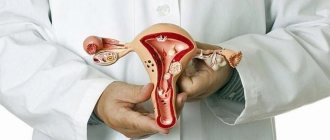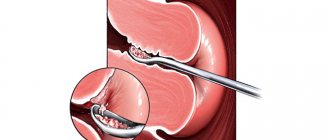Normal discharge after cesarean section - what does it look like and how long does it last?
In the early postoperative period, discharge after cesarean section can be easily compared with normal heavy menstruation - the lochia is colored red and contains individual clots.
In the first 7 days after surgery, their total volume can reach 500 ml; normally, a sanitary pad should be filled no faster than 2 hours. Every day the doctor checks with the woman the number of lochia and their color.
Discharge after cesarean section increases with physical activity, breastfeeding, and palpation of the abdomen. As a result of these actions, the natural contractile activity of the uterus is stimulated, due to which its contents are more effectively expelled.
From the 2nd week, the lochia begins to darken, acquiring a brownish tint. Their volume gradually decreases. By the end of the 5th week, blood discharge after a cesarean section should normally become spotty, weak and acquire a lighter shade.
At the 8th week, the process of restoration of the inner layer of the reproductive organ is almost completely completed. Thus, the discharge after a cesarean section becomes light after 2 months, just like before pregnancy. At this time, the woman is recommended to visit a gynecologist for an appropriate examination and selection of a contraceptive method.
The nature and intensity of lochia is influenced by contractions of the uterine myometrium. After a birth performed by cesarean section, this process is worse than after a natural one, since part of the muscle fibers are damaged as a result of the surgical incision.
To improve the contractile activity of the uterus and prevent the development of postpartum hemorrhage, immediately after the operation the woman is started to be administered the drug Oxytocin according to the scheme, and it is also strongly recommended to establish natural feeding to enhance the synthesis of oxytocin by the body.
Hygienic self-care during the postpartum period
Following these simple recommendations will allow a woman to prevent the development of infection and postpartum hemorrhage:
- Stock up on overnight pads (or even cotton ones) early on; the use of tampons is strictly prohibited (during this period they are a source/spreader of infection).
- After some time, when the discharge becomes less, you can switch to lighter pads (which should be changed every 3 hours). You still can't use tampons!
- A bath is not recommended, but a shower is preferable. Among other things, you should wash the genitals and perineum several times a day (preferably after using the toilet). Swimming in public pools is prohibited.
- Try to urinate more often to keep your bladder clean (this will prevent infection). After giving birth, your urinary system becomes less sensitive in the first few days: a woman may not feel her bladder is full during this period, which makes it harder for the uterus to heal (and may lead to more bleeding).
- It is necessary to devote a lot of time to rest. Active physical work can cause bleeding even after postpartum lochia has ended.
Personal hygiene after cesarean
Personal hygiene after surgical delivery has its own nuances:
- Sanitary pads are changed as needed, but at least every 3 hours.
- The use of tampons during the postpartum period is strictly prohibited, since their use can cause the development of an infectious process.
- After each visit to the toilet, a woman should wash her genitals with clean water.
- You cannot douche or take a bath until the end of the recovery period, only take a shower.
Causes of unpleasant symptoms
In case of complications after surgical delivery, the patient has the right to contact the medical institution where she had a cesarean section (within 40 days).
Deviations may occur in the following situations:
- An unprofessional operation (leaving particles of the placenta or amniotic sac in the uterine cavity). Cleaning or re-intervention will be required.
- The inability of the female body to recover without the help of medications.
- Curvature of the uterus, cervical spasm.
- Inflammatory process.
Important! At the first signs of complications, all measures must be taken to eliminate them. Otherwise, hospitalization will be required, and the newborn will be left without maternal care for a long time.
In what cases should you consult a doctor?
Every woman who has become a mother through surgery should be informed about how long the discharge lasts after a cesarean section. The cessation of lochia too early, as well as prolonged cessation, can be a bad sign.
But doctors insist that it is not so much the time frame that is important, but the composition, color, smell and total number of lochia. If the nature of the discharge is normal, then there is nothing to worry about. And how long the discharge lasts after a cesarean section depends almost entirely on the specific characteristics of the body. But even in this situation, you should consult a doctor.
It is imperative to inform a specialist if lochia ends too early - less than 5 weeks, or too late - continues 10 or more weeks after birth. Both of these conditions pose serious risks.
In the first situation, the uterus may not have been completely cleansed and blood, mucus and remnants of the epithelium remain in it, which often ends in a serious inflammatory process. This should be indicated by discharge after a caesarean section with an odor. Read more about why the uterus contracts poorly after childbirth→
Prolonged lochia is also the result of an infectious process - endometritis. There is also a danger when the discharge either ends or increases again: such a case also does not fit into the norm.
Yellow discharge after cesarean section without the presence of a foreign odor is normal only at the end of the first 3 weeks after birth. But if they continue after this time, they are considered a sign of pathology - an advanced form of endometritis, which must be treated under the supervision of a doctor.
Purulent discharge after cesarean section colored green indicates the presence of an acute infectious pathology in the uterus.
White discharge from the genital tract is not dangerous until it is accompanied by symptoms such as redness and itching in the intimate area, discharge with a sour odor and a cheesy consistency. Most likely, we are talking about vaginal candidiasis - a frequent companion to antibacterial therapy, which is necessarily prescribed after surgical delivery. But only a specialist can give an accurate diagnosis.
By observing how long the discharge is after a cesarean section, assessing its nature, the young mother will understand whether her postpartum recovery stage is being delayed or everything is fine. If deviations from the norm occur, do not hesitate to consult a doctor.
The examination and course of treatment that you will have to undergo if necessary are trifles compared to the complications that can arise if you let the situation take its course.
Surgery: Types of Clots
Lochia is an intense discharge from the female genital tract after a cesarean section. They contain cells of plasma, blood, old epithelium and mucus. Most women perceive them as menstruation. But their characteristic smell, color, volume, composition is the main indicator of the state of the young mother’s body.
After some time, the bleeding stops, the number of lochia decreases significantly, and they acquire a thick structure. The color of the lochia gradually changes as the injured surface heals.
Caesarean section is accompanied by discharge that changes color in stages:
- red-scarlet;
- red;
- serous-bloody;
- brown with a red tint;
- rich brown;
- intensely brown;
- shade of light brown;
- yellow mucous membranes;
- yellow discharge with flashes of white;
- unpleasant serous lochia with ichor;
- completely colorless mucous membranes.
Important! If the blood discharge contains intense green clots, pus, or has a scarlet tint for a long time, you should urgently consult your doctor.
What else should you pay attention to?
A woman should be concerned not only about the changed nature of postpartum discharge, but also about such alarming signs as abdominal pain and fever.
But the last symptom may also be a variant of the norm if the young mother has not yet established lactation and the first pronounced flow of milk is observed.
Sometimes, due to insufficient care or infection, a woman in the postpartum period develops discharge from the suture after a cesarean section.
This pathology is characterized by the following symptoms: hyperemia, fever, swelling and sanguineous or purulent discharge from the suture after cesarean section.
If you do not notice this complication in time or self-medicate, the suture will fester and the young mother will need surgical help.
Typically, every woman who has become a mother by cesarean section visits a specialist 2 months after the birth of the baby. During this time, it becomes known how the recovery process is proceeding and whether there are any complications.
But the woman will have to monitor whether postpartum discharge is normal on her own in order to seek medical help in time.
Author: Olga Rogozhkina, doctor, especially for Mama66.ru
Quantity
A young mother also needs to pay attention to how much lochia comes out of her in order to judge how the body’s recovery is proceeding. If after a cesarean section there is little discharge, especially in the very first days, this may be an alarming signal that the tubes, uterine ducts are clogged, a blood clot has formed, etc.
The opposite situation is no less dangerous: profuse lochia that does not stop for too long is an alarming signal about the impossibility of full restoration of the uterus after surgery. In both cases, you need to undergo a special examination and find out what is the reason for such deviations.
Any woman wants postpartum lochia to end as soon as possible and nothing to overshadow happy motherhood. However, there is no need to be too hostile towards them. It is they that can serve as that alarming and sometimes the only signal that not everything is in order with the restoration of the body and some measures need to be taken to help it. You should especially be wary of discharge after a cesarean section with an odor and an unrealistically bright hue. This almost always ends with a course of antibiotic treatment, which is highly undesirable during lactation, or another surgical intervention.
Doctors' recommendation
There are a number of conclusions about the dangers of washing cosmetics. Unfortunately, not all new mothers listen to them. 97% of shampoos use the dangerous substance Sodium Lauryl Sulfate (SLS) or its analogues. Many articles have been written about the effects of this chemistry on the health of both children and adults. At the request of our readers, we tested the most popular brands.
The results were disappointing - the most advertised companies showed the presence of those very dangerous components in their composition. In order not to violate the legal rights of manufacturers, we cannot name specific brands. The Mulsan Cosmetics company, the only one that passed all the tests, successfully received 10 points out of 10 (check out). Each product is made from natural ingredients, completely safe and hypoallergenic.
If you doubt the naturalness of your cosmetics, check the expiration date; it should not exceed 10 months. Be careful when choosing cosmetics, this is important for you and your child.
Regardless of whether the birth turned out to be natural or surgical, the inner lining of the reproductive organ needs time to recover. On average, it lasts 5-9 weeks, unless complications arise. Particular attention is paid to discharge after cesarean section. In obstetrics they are called lochia.
Lochia includes blood, rejected epithelial particles and mucus. There are no fundamental differences between the discharge that occurs after a physiological birth and those that appear after a cesarean section. Most women treat them like menstrual bleeding. By indicators such as the smell, color and volume of discharge after a cesarean section, you can judge whether everything is all right with the new mother.
Useful video about caesarean section
We recommend reading: Uterus after cesarean section: features of the recovery period
A caesarean section is a serious abdominal operation that does not occur without complications and requires a long process of recovery of the woman’s body. How long it will last depends on many individual characteristics; it may take from 42 to 56 days, while the body after a natural birth completely returns to normal within a month. One of the consequences of labor is lochia, which appears regardless of the type of birth, but in the case of artificial obstetrics requires special attention, because it can indicate more serious complications.











